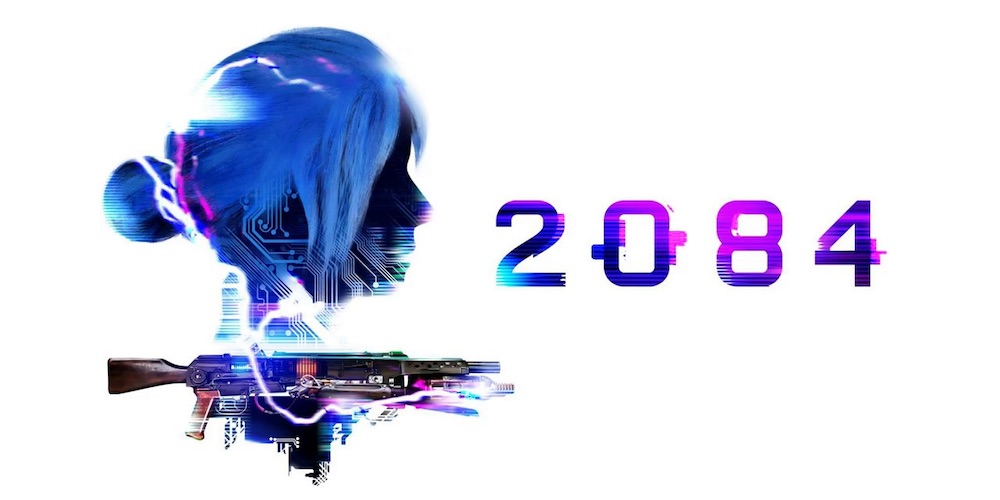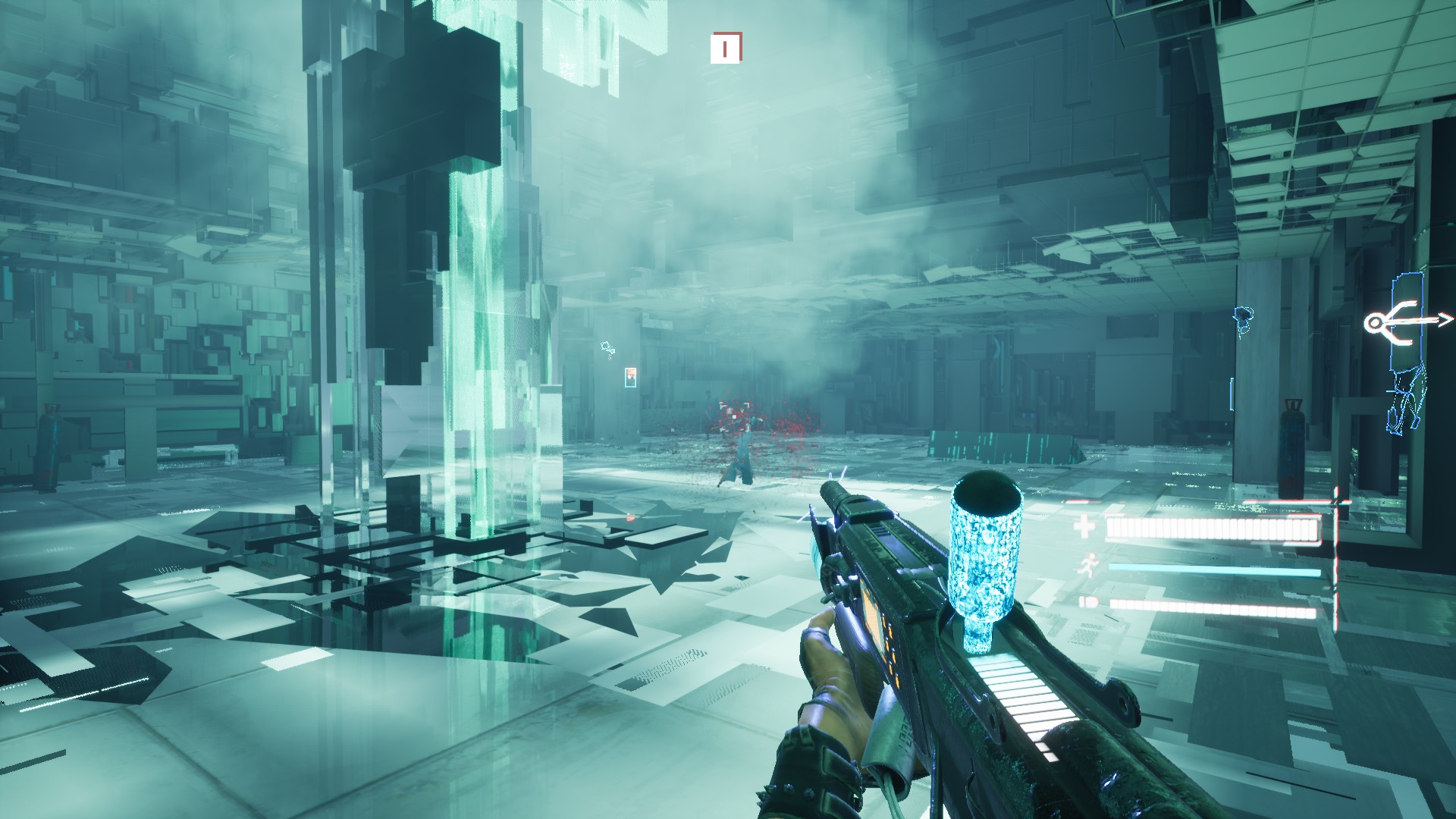
I have reserved feelings about the notion of early access titles. The more criminal elements of my imagination see it as little more than a liability for leaving over-eager consumers both penniless and largely unsatisfied for the duration of a game’s shelf-life. Every once in a while, though, I am proven so overwhelmingly wrong by something like Dead Cells which reminds me that, occasionally, you need to take a chance on things. Enter 2084, an early access single-player cyberpunk shooter with “hacking elements,” a project borne out of a game jam between devs who’ve worked on the likes of Layers of Fear and Observer.
Now, I have to admit something pretty stupid here – I didn’t read 2084’s Steam page before I started playing. I have played through more shooters in my time on our speck of space dust than most would consider tasteful. I like to think I know what constitutes a good FPS in some different schools of thought. To wit, my initial impression of 2084 was…bad. The big caveat is that 2084 is currently only a prototype. And that was particularly confusing, as 2084 already has quite polished art assets, fully voiced cinematics, and a plot with a twist that offers a bit of real intrigue. Usually, those sorts of things are secondary in shooter design to making the actual shooting fun. Whatever positive impression the visual fidelity in 2084 had on me was quickly tossed in the dumpster once I read that Feardemic put this thing together in 3 days. The art assets then, are arguably recycled from the team’s previous work, and thus the lustre they once had suddenly seemed less so.

Before I start to reveal myself for the calloused sphincter that I am, the basic premise and plot of 2084’s prototype is kind of cool. Casting players as an employee of a large tech corporation enjoying a VR game, whose living quarters are undergoing lockdown for some recurring biological contamination. Scantily clad in her bra and figure-hugging jeans for some reason, we play her entertainment alongside her, which is a horror-themed action shooter. While the story is only about an hour long, things get weird and meta by the end of it, in the sort of solipsistic mind-screwy horror way that was bound to become increasingly well-explored among other games in a post SOMA and Superhot world. I dig it and would love to see where it goes in the future.
As I said before, however, the gameplay in 2084 is a bit rubbish, but its basic concept is one I’ve seen attempted in other cyberpunk shooters with some success. Immediately upon playing 2084, I was reminded of the likes of Project Snowblind and the failed Syndicate reboot. Both of those games were good products for their respective times, but 2084 very much feels like where Feardemic is going to learn a lot of hard lessons about developing in a new genre. Currently, there is a single weapon in the game, which is an assault rifle of sorts with a silly capacitor looking doodad gregariously attached to the top of it. This doodad indicates the status of your hacking ability, which is, in fact, a physical projectile you can shoot at various world objects, resource panels and enemies. “Well, Alex, I don’t understand why you’re such a bag of dicks about this game, that idea sounds cool.” Oh, my well-meaning friend, how right you are. The problem is not the idea. It’s the granular details of how the weapon interacts with the environment and with the enemies.

The gun fires at a different rate depending on how much ammunition you have stocked in your clip. You can never truly run out of shots, but with a drained clip, you will fire at a slow semi-auto rate. The rate of fire then ascends the more ammo you have. You can over-stock your clip, but it’s impossible to discern by how much once you do, as the ammo meter will merely turn red and stay so until you start getting close to emptying the pool. It’s also unclear by how much it is possible to overstock it by. Running out of ammo is bad enough in a shooter, but being punished for mowing down enemies (the sole objective in this game) as you’re doing it is a bafflingly arbitrary design choice, and I hope it changes soon. Worse still, this trait had a cumulative effect when combined with the environmental and encounter design problems I ran in to.
The levels are rendered in a most evocative fashion, as I mentioned earlier. Moodily lit dirty streets littered with trash and debris, decaying slums, and the occasional bit of art-deco architecture juxtaposed with futuristic mcguffins all about the place lend 2084 a nice atmosphere, even if it is ripped wholesale from Observer. It looks great. Architecturally, from a functional point of view, though, it’s garbage, and too dark to spot enemies effectively in. “Oh, but this is a horror-themed shooter, Alex, you curmudgeonly dork,” Well, friend, the only thing that’s horrifying in 2084 is how difficult it is to see enemies who may or may not be hitting you. The first level is a series of ultra-narrow corridors with the most egregious monster closets I’ve seen since I dared to attempt a replay of DOOM 3. Feardemic were very aware of how disorienting the opening stage is, plastering large neon arrows over walls to arbitrarily guide players through the clusterfuck of a labyrinth they’ve thrown them into. To Feardemic’s credit, levels do open up gradually at thoughtful pace over the three levels currently in the prototype, but in all honesty, my heart sank at the prospect of having to dig through the jarring opening level. It’s not a good sign when you have to remind yourself constantly this is early work to get through what’s on offer.

Now, the meat of shooting game isn’t just in its guns; it’s engaging enemies who apply pressure on a player and force them to get creative with the tools available to them. Encounters in this game center around “hacking” your enemies and surroundings, and the concept works…well kinda. The secondary fire on the only gun in the game is a projectile that, when it comes in contact with an interactive environment object or a particular type of enemy, it will ask for a series of directional inputs from your movement keys to be press within a second or so. The rest of the game will slip into slow-motion as a hack is occurring, and the results of successfully hacking your opponents and world objects does yield some useful and weird results. Various traps in the world can stun groups of enemies, but so can enemies with televisions for heads (yes, you read that correctly). Drying machines can be brought to life to act as seeker mines, and security cameras can be activated into stationary turrets. These interactions are fun and lend the combat a sense of novelty, but the range on the hacking module was a major frustration during my time with 2084. Most objects need to be approached from the front, and at a very narrow-angle to be hacked. It also takes a bit too long to recharge, It’s frustrating to die as a result of such a silly niggle, but as I said before, these problems are cumulative. There is a basic dash function, but I found it to be both disorienting and a bit too generous for the cramped spaces in which fights take place.
Lastly, the enemy design doesn’t so much suck as it does indicate a lack of experience with the genre. In the story mode, there is a single enemy type, a zombie, thrown at the player in a variety of sizes, sometimes with a TV on its head. They range from ceiling breaking giants to ankle-biting pipsqueaks that are near impossible to see in the dinge-laden environments. There are some bosses, granted, but you’re not likely to be impressed, especially considering the first one thrown at you is just a slow spinning cube with lasers on it. They’re bog-standard enemies to fight at best, and laughably silly or downright aggravating otherwise. This is where 2084 needs the most work to become a worthwhile product.

In its current state, 2084 is more show than substance. It represents a stepping stone for a set of established developers hoping to break into a new genre, but it has a loooong way to go. I wouldn’t recommend buying it in its current early access state, regardless of its intriguing plot, as it’s more frustrating to play even over an hour’s worth of content to seem worthwhile. With more interesting opponents and more forgiving environmental design, as well as some basic functionality to tweaks to the weapon, 2084 could be quite good. I will keep an eye on it, but for now, if you want to see how people get good at making FPS games, you should watch it from afar.











